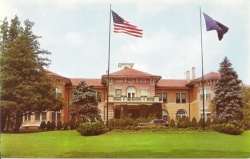Madison State Hospital
| Madison State Hospital | |
|---|---|
 | |
| Construction Began | 1907 |
| Opened | 1910 |
| Current Status | Active |
| Building Style | Cottage Plan |
| Location | Madison, IN |
| Peak Patient Population | 2,000 est. in 1955 |
| Alternate Names |
|
History[edit]
On Feb. 21, 1905, the Indiana legislature passed a bill to construct a mental institution in southeastern Indiana. A commission named for the purpose chose Madison as the site of the institution. It was built mostly on land purchased from Henry and Ford Hitz at $100 per acre, atop the hills overlooking the Ohio River. The first patients were accepted at the new Southeastern Indiana Hospital for the Insane on Aug. 23, 1910. The approximately 600 patients were transported here from Central State Hospital in Indianapolis by train. Guards who stood watch over them carried shotguns loaded with rock salt.
There were 30 two-story buildings with 20 to 70 beds each to house the patients, with the buildings being placed in a symmetrical pattern with administration and service buildings in between. Men’s buildings were on one side of the grounds, women’s buildings on the other. Heretofore, mental patients had been “warehoused” in huge buildings. But the new, enlightened view of “moral treatment” current in the early 20th century was that disturbed minds could be restored to sanity in a beautiful, peaceful and accepting environment such as the new state hospital offered, with its breathtaking view of the Ohio River Valley. The breaking up of the patients’ housing into smaller buildings, known as the cottage plan, also was aimed at more humane treatment of the mentally ill and at trying to restore them to sanity.
The name of the new institution was changed to Madison State Hospital in 1927. But from its earliest days, the institution came to be known locally as “Cragmont,” a nickname that died out only in recent years. Brains of long-deceased patients, which were studied after the patients’ deaths as part of the research into the disease, are preserved at the museum. Other studies were done of criminal sexual psychopaths, and of the results of the abuse of drugs and alcohol. Involved in the various studies were such physicians as Dr. George Zirkle, Dr. Peter King and Dr. Ott B. McAtee, who was the superintendent for many years. Among the buildings that pre-date the establishment of the state hospital, the gatehouse is one of the very few that have survived. The stone portion in front dates to the 1840s; the rear part, to 1926.
Shortages of money became a problem in the 1930s during the Great Depression. The staff-to-patient ratio suffered a tremendous imbalance, with 110 attendants caring for 1,585 patients. As a result, some treatments, such as shock and hydro therapy, could not be given because of high costs. Many patients were staying at the hospital longer than necessary as a way of keeping it operating to meet state funding requirements. Administrative changes also had an impact on the facility. During the 1940s, the hospital saw five different superintendents. By the late 1950s, the patient population began to decline rapidly, partly due to new medications & treatments. Today, there are approximately 100 patients, divided into 8 different units.
Images of Madison State Hospital[edit]
Main Image Gallery: Madison State Hospital
Cemetery[edit]
There is a small cemetery on the property that holds 300-400 graves, only 17 have markers with names.

